Update, November 8, 2018: Thanks to the research efforts of my brilliant readers, I’m able to update this post with information about the group above. The following quotes in italics are from a web page, Friends War Victims Relief Committee in the Franco-Prussian War, on the site quakersintheworld.org:
The first official Friends War Victims Relief Committee (FWVRC) was set up in 1870, following the outbreak of the Franco-Prussian War – seven years after the founding of the Red Cross and six years after the signing of the Geneva Convention.
Through the agency of 41 commissioners (33 men and 8 women), the FWVRC undertook relief work among the civilian population of towns and villages devastated by the war. Many of the commissioners already knew the countryside well – some as scholars, some as members of the Alpine Club – and spoke French or German or both. They set out to help French and Germans equally – the first occasion this policy of “no discrimination” was formally adopted.
As soon as the first commissioners – William Jones and Henry Allen – began work, it became clear that a recognisable symbol was needed to identify the commissioners, their transport and the goods they carried. The now familiar red and black star of the Quaker relief worker was in fact the symbol of the London Daily News, which was then also funding relief work.
This was also the first occasion that women worked alongside men, as opposed to having their own, parallel relief organisations – though that seems to have happened almost by accident, in response to an urgent need to simply roll up their sleeves and get working.
Their work fell into three phases. Firstly, following the siege of the town of Metz, they provided emergency famine relief, and later experimented with the new-fangled steam ploughing in order to provide urgently needed help with planting the next harvest.
Update, April 2019: I purchased a copy of the booklet They Chose The Star: Quaker War Relief Work in France 1870-1875, by William K. Sessions, 2nd ed. (1991). It contains photographs of many of the commissioners, which have helped me to identify several sitters in the photograph above. The man in back at far left is John Dunning (1826-1885) of Middlesbrough. The young woman sitting next to him is Ellen Jackson. The man at left in front is Dr. Thomas D. Nicholson of Birkenhead. The man at right in front may be Charles Wing Gray (1845-1920) of Halstead, Essex. The man at right in back may be Samuel James Capper (1840-1904) of Liverpool.
Sessions writes on page 22 of They Chose The Star:
Nearly six months after the first commissioners entered Metz, the depot was finally closed by Thomas D. Nicholson and Charles W. Gray, who returned to England on 10th April, 1871.
Multiple sources mention that John Dunning first went to Metz in December 1870, then returned to England, then went back to Metz for about a month in the spring of 1871. If all the commissioners left Metz by April 10, we can assume the photo was taken in March or early April 1871.
The carte-de-visite was made at the studio of L. Krier & Cie (company). Metz is in northeastern France, near the border with Luxembourg to the north and Germany to the east.


The J. Paul Getty Museum has one CDV by L. Krier in its collection, but the photo isn’t displayed on the museum’s website.
Page last updated April 18, 2019.

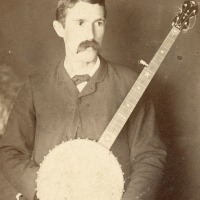
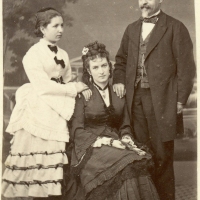
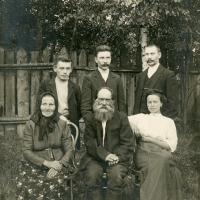
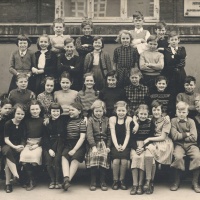
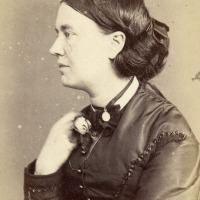
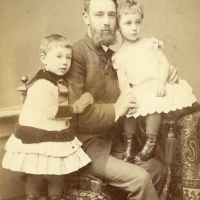
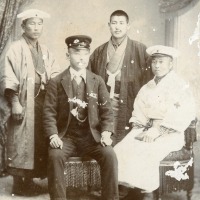
I was curious about the symbol on their armbands. After some quick research online I found that the 8-pointed star has various meanings in several cultures and religions. I wonder if this group was doing some occult research.
LikeLiked by 3 people
Interesting theory! I saw a variety of stars online, but none exactly like this one. The closest might be a compass rose, which has four large points and four small points. I suppose this group could be involved in exploration, navigation, or search and rescue, something involving a compass. Your idea is just as good, though. Thanks for chiming in, MM!
LikeLiked by 3 people
Ooh! I hope someone will be able to solve this mystery! So fascinating.
LikeLiked by 2 people
Yes, and it’s especially nice when my readers do the work. 😀
LikeLike
Very intriguing mystery. Thank you for posting it. Is there anything inside rhombus on the bandage? May be it is a medical cross. As always I first think about medicine)
LikeLiked by 2 people
I looked as closely as I could, and it’s impossible to see if there’s any kind of symbol at the center of the star. Frustrating! But you’re right, my first thought was that it might be a medical symbol. The International Committee for Relief to the Wounded (the Red Cross) was founded in Switzerland in 1863. This photo was probably taken a few years later, maybe 1866-1870 (a guess). There might have been local organizations, with different symbols, in cities like Metz. Good thinking!
LikeLike
It’s a strange grouping with the two men sitting on the floor. And none of them are looking at each other. They seem sort of detached.
LikeLiked by 2 people
I know what you mean. It was common for sitters to look away from the camera. I’m not sure what the reasoning was, if it had to do with lighting, or if it was thought to produce more attractive portraits, or if there was some other reason. I’ve seen group shots from as late as the 1910s where everyone is looking in a different direction, but by then it probably had to do with the use of high-powered lighting. It creates an interesting tableau, even more so when people are sitting on the floor. Thanks for stopping by! Are you back home?
LikeLiked by 1 person
Yes, Just got back to Amsterdam last night! Will be here for a few months now.
LikeLiked by 1 person
Could they be Quakers?
https://en.wikipedia.org/wiki/American_Friends_Service_Committee
This article says the group which used that sort of star was American, but they came over to Europe during World War 1, so it’s not inconceivable that a group of them was photographed in Metz.
LikeLiked by 1 person
It does look like the same star! The photo was probably taken in the late 1860s or early 1870s, so the question will be whether the star was already in use by Quakers 50 years before the AFSC was founded (1917). I bet it was! This is a great lead to pursue. Thank you!
LikeLike
Interesting photo, and I agree with Little Sparrow that it looks like the Quaker star. Could you ask on this blog (which I found just now) as they are Quakers and presumably know their own history. https://quakerstrongrooms.org/
LikeLiked by 1 person
Thank you, Val! The blog you found doesn’t seem to have information relating to Metz or to the War Victims Relief Committee in 1870-71. However, the Library of the Society of Friends, which writes the blog, has a list of resources I could use to try to find more information.
LikeLiked by 1 person
Here is a site discussing quakers helping in the franco prussian war (1870)and metz is mentioned. So are several names of British quakers involved. The symbol apparently came from a london newspaper. They also say it was the first time women and men worked together in such a relief effort because the need was so dire.
http://www.quakersintheworld.org/quakers-in-action/299/Friends-War-Victims-Relief-Committee-in-the-Franco-Prussian-War
LikeLiked by 2 people
Fantastic, Andrea! I spent a couple of hours this morning reading about the Friends Foreign Mission Association, which was founded in 1868. They were doing regular missionary work, rather than war relief, and I didn’t find any reference to them using the star. It makes sense that people doing war relief would need to be clearly identifiable, while missionaries wouldn’t. You’ve solved the second part of the puzzle! Now we just have to identify the people in the picture. 🙂
LikeLiked by 1 person
It’s not surprising that women worked alongside the men as the early Quakers were very devout Christians who believed in service to others and also where women were on equal spiritual standing with men. During the unprogrammed services both men and women would gather in a simple room and sit quietly in expectant waiting for the Holy Spirit to prompt them to speak a message from God. Both men and women could do that. Such services were very contemplative, and nothing had to be spoken at all. The presence of the Holy Spirit was enough.
LikeLiked by 1 person
Thank you, Linda. Traveling to a foreign land in time of war would require a strong commitment to service, especially in 1870. Not all members of the FWVRC were Quakers, but some were definitely motivated by their faith.
LikeLike
First time I have seen people from that time period sitting on the floor.
LikeLiked by 1 person